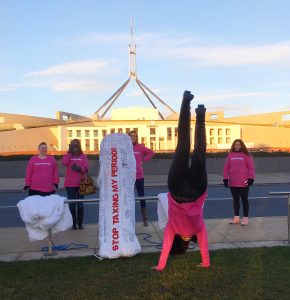Student Voice Network
Youth Organisation
“The Student Voice Network is proud to support Girls Uniform Agenda in not only their quest in making sure all girls, at all schools can wear the uniform they desire but in their drive for gender equality.”
Student Voice Network website: www.svn-au.com Insta: @svn_au
Michelle Redfern
Founder Advancing Women, Advocate for Gender Equality & Women in Sport, AFR 100 Women of Influence 2018
“I’m so pleased that Girls’ Uniform Agenda is lobbying for equal rights for girls in Australia. Why should girls and young women be forced to wear garments that restrict movement, healthy activity, that are not purposeful, all weather garments and be forced into rigid gendered stereotypes, from such a young age?
The Girls Uniform Agenda tells girls and young women that they are valued, equal and that we respect their right to choose what garment works for them. Bravo!”
Twitter: @RedfernMichelle; Facebook: @AdvancingWomenInBizandSport Insta: @advancewithmichelle
Young Women’s Advisory Group (YWAG)
Young Women’s Advisory Group to the Equality Rights Alliance. Lifting young women voices in national policy.

“Enough is enough, it’s 2019 and we need to just let girls be girls. Just like boys, girls need to run and jump and play unencumbered by outdated notions that stifle their ability to actively participate in their own lives. Anyone who’s ever tried to do a handstand in a dress knows how restrictive they can be! Research shows the deleterious and compounding impact that traditional gendered views has on girls. As such, we firmly stand with GUA in changing school policies to give girls and young women the option to wear the pants too!
YWAG- Facebook: @LetsTalkSurvey Insta: @ywag.era
Alex Lee
ANU Student, Jasiri Trailblazer Fellow 2018

“When we tell girls to wear skirts rather than pants, we tell them: to sit rather than play; to watch rather than participate; to focus on how their bodies look rather than what they can do. It makes sense for girls to choose what they wear- for the sake of their physical freedom, empowerment, and self-view.”
Alex Lee
Dr Mehreen Faruqi
Greens Senator for NSW

“Girls should be able to play sports and be active without any barriers at school. Students of all genders should be able to choose what they wear to school, it’s really a no-brainer!”
Dr Mehreen Faruqi
Twitter, Facebook, Insta: @MehreenFaruqi
Professor Clare Hanlon
Institute for Health and Sport, Victoria University
“To help girls feel ‘ready’ for school, they need to feel confident and comfortable in school uniforms. Girls need to be provided with appropriate ranges of uniform styles, they like options. I warmly support the focus of Girls’ Uniform Agenda; it provides ‘the voice’ to help policy makers understand the importance of implementing informal and formal uniform options.”
Professor Clare Hanlon
Emmanuelle Mattana
Actor, star of Mustangs FC

“It seems beyond imaginable that in 2018 uniform policy and the freedom and wellbeing of the nation’s children are being dictated by a desire to rigidly enforce archaic gender roles.
When women today are continuing to fight for equality and equal representation in so many domains it is beyond time that girls in their formative years are no longer forced to be both passive and vulnerable.
If we truly want young women to thrive in our communities and workplaces, addressing the inequity of uniform choice is a powerful first step to gender equality. I can’t possibly understand why not?”
Em Mattana
Megan Mitchell
National Children’s Commissioner
 “It’s the 21st Century and if we truly believe in gender equality then we should support girls in their choice to wear practical and comfortable clothes to school.”
“It’s the 21st Century and if we truly believe in gender equality then we should support girls in their choice to wear practical and comfortable clothes to school.”
Megan Mitchell
Twitter: @MeganM4Kids
Maria Delaney
Director of the Social Change Agency and RESPECTability services for schools

It’s about so much more than shorts and pants! Narrow and rigid gender stereotypes and expectations operate in schools, as in society more broadly. Beyond the ‘three Rs’, our work as educators is to cultivate courageous change agents. What example do we set? Equitable uniform policy demonstrates a school’s awareness and valuing of gender equity, and is part of a whole community approach to building respectful relationships and preventing discrimination and violence.
Maria Delaney – www.socialchangeagency.com.au
Louise Lenzo
Senior Educator Early Childhood
Women’s Officer Unions NT, Junior Vice President Independent Education Union Queensland Northern Territory Branch, Equity Convenor
 “I am proud to be a supporter of Girls’ Uniform Agenda. As an early childhood educator for the past 25 years, I have witnessed on a daily basis the struggles girls face due to the restrictions of a strict uniform policy where the only option for girls is to wear a dress. I believe it’s time to progress from these outdated policies and ideas and allow students the independence to choose a gender neutral option where play is unrestricted and freedom of movement is a priority, especially so in the early years.”
“I am proud to be a supporter of Girls’ Uniform Agenda. As an early childhood educator for the past 25 years, I have witnessed on a daily basis the struggles girls face due to the restrictions of a strict uniform policy where the only option for girls is to wear a dress. I believe it’s time to progress from these outdated policies and ideas and allow students the independence to choose a gender neutral option where play is unrestricted and freedom of movement is a priority, especially so in the early years.”
Louise Lenzo
Coleen MacKinnon
Principal, Inclusivity Quotient (InQ); Advisor CA Male Champions of Change

“It’s a pleasure to support the work of Girls’ Uniform Agenda. As is now well-established, narrow gender norms and expectations are formed from a very early age. By the age of six, girls see themselves as less talented than boys, thanks to a heavy dose of implicit and explicit messages imparted by parents, peers, teachers, coaches, advertisers and the media. If we truly believe in a gender equal future, we have to begin by challenging beliefs and traditions that no longer serve us, or our children—including gendered uniform policies. We’ve long since moved past this in the workforce. Why not in our schools?”
Coleen MacKinnon www.inclusivityq.com.au Twitter: @CMacKinnonAUS
Caitlin Figueiredo
Founder and CEO of Jasiri Australia

“On my first day of year six, I remember walking into my new school wearing pants. I wanted to feel comfortable and free to run around and make new friends. Big mistake. I didn’t realise that at that school, girls were not allowed to wear pants. So, instead of being welcomed, I was sent to the Principal’s office. Ever since, I have been an advocate for gender neutral uniforms.
Ensuring all schools have a gender neutral uniform policy is one small step towards achieving gender equality. No school should be able to dictate what a girl should or should not wear. That’s why I’m a supporter of this campaign. Because gender equality starts from a young age and having the freedom to wear pants is one element towards emancipation.”
Caitlin Figueiredo www.jasiri.org.au Facebook: Jasiri.org Twitter: @CaitFigueiredo Insta: @jasiriaustralia @caitlinfigueiredo
Rochelle Courtenay
Founder of Share the Dignity

“Girls should be able to be active and have fun at school. They should always be able to handstand at break-times and you can’t handstand in a dress or skirt! Let girls handstand!
Campaigning and handstanding to axe the tampon tax #axethetaxperiod #axethetax #letgirlshandstand
Rochelle Courtenay – www.sharethedignity.com.au Facebook.com/sharethedignity Twitter: @sharingdignity Insta: @sharingthedignityaustralia
Jo Hirst
Author & Advocate for Trans and Gender Diverse Children & Their Families

“It is the responsibility of schools to provide a safe learning environment for children. A big part of this is ensuring all students feel comfortable with what they are wearing. Young people need to know that their well being and who they are is valued above their appearance.”
Jo Hirst – johirst.com
Facebook: JoHirstTheGenderFairy/ Twitter: @thegenderfairy1 Insta: @thegenderfairy
Jacqueline (Jax) Rousselot
Year 12 student, Plan International Australia Ambassador
“How can students or their parents trust schools that are so outdated that they prioritise girls’ appearance over their health, when these are the very institutions that are supposed to educate, equip and prepare children for the future?
My school has not yet agreed to add a pants option to the girls’ uniform, citing “tradition” as an excuse. But child marriage, child labour, and even slavery were once “tradition,“ rendering such a justification both inadequate and offensive. Tradition always restrains progress in human rights.
I ask all schools with gender-specific uniforms: the war against gendered uniforms is here. Why are you still fighting on the wrong side?“
Jax Rousselot
Emma Kearney
AFLW player – 2017 Best & Fairest Western Bulldogs, 2017 All Australian team, WBBL player – Melbourne Stars, Physical Education Teacher
“As a PE teacher I have seen firsthand the damage forcing girls to wear school dresses has on the individual. They are completely restrictive which discourages girls from being active, something that has been an ongoing issue for quite some time.
Girls are already placed in a stereotype where it is seen to be ‘non feminine’ to be active and play sports. They certainly don’t need the further push they are getting by being forced to put on their school dress each morning. In this day and age we are beyond this and girls should be given the option to wear dresses, shorts or pants.
When I was in primary school it was such a pain playing both footy and cricket in the dress. I was always so excited when we had PE, because I could wear my PE uniform for the whole day. In the PE uniform I wasn’t restricted when I played and I didn’t show my undies when I was bowling at cricket. I was always much happier when I could wear pants to school.”
Emma Kearney
Ashleigh Streeter
Plan International Youth Activist and UN Youth Task Force

“I absolutely adore this campaign. I went to a girl’s school which offered the option for trousers in the winter but never stocked them in the uniform store. As a result, 99% of students didn’t know they were an option. As someone who liked to challenge the status quo and who HATED pulling up tights, I detested wearing a skirt. I detested being told to “sit like a girl”, a remark which was often made when I was in a dress but never in trousers.
There was so much tied up in the value of the skirt that it stopped us focusing on what really mattered, our education and our journey to become good people. School is meant to prepare you for the real world, and the real world doesn’t have a dress code which is strictly divided into dresses or skirts.
The reality is that it’s 2017. I go into parliament to campaign and advocate for women and girls, and many of the women there aren’t wearing either dresses OR skirts. Neither am I. It’s time that we stop judging women by the way they dress, give them choices that reflect the workplace, and focus on what really matters – supporting girls and young women no matter what choices they make.”
Ashleigh Streeter – Insta: @activist.ash Twitter: @ashstreeterrrrr
Equality Rights Alliance
Equality Rights Alliance is Australia’s largest network advocating for women’s equality, women’s leadership and recognition of women’s diversity
 “No more skirting around the issue, girls wear pants too! We know rigid gender stereotypes and norms are a root cause of gender inequality. School uniform policies should support the clothing choices of girls and young women, not restrict them based on gender stereotypes or the flawed notion that ‘it’s always been this way.’ This sets in motion the message that what you wear is more important than who you are and what you do. For decades now, girls have been speaking out against restrictive uniform policies, we stand with them and the incredible efforts of GUA to bring uniforms into the 21st Century.”
“No more skirting around the issue, girls wear pants too! We know rigid gender stereotypes and norms are a root cause of gender inequality. School uniform policies should support the clothing choices of girls and young women, not restrict them based on gender stereotypes or the flawed notion that ‘it’s always been this way.’ This sets in motion the message that what you wear is more important than who you are and what you do. For decades now, girls have been speaking out against restrictive uniform policies, we stand with them and the incredible efforts of GUA to bring uniforms into the 21st Century.”
Equality Rights Alliance –www.equalityrightsalliance.org.au Facebook: @equalityrightsalliance Twitter: @eraaustralia
Professor Philip Morgan, PhD
Co-deputy Director of the Centre for Active Living and Learning, University of Newcastle. Founder of the Daughters and Dads Active and Empowered (DADAE) program

“Girls are marginalised in many sport and physical activity contexts and face a huge range of barriers to being active. One barrier that should be removed for all girls is restrictive school uniforms. Research unmistakeably shows that children are more active when dressed appropriately. Wearing a dress or tunic serious limits a girl’s ability to be active, play sports, develop movement skills, stay fit and to experience play, risk and challenge.
Given the huge physical, psychological and educational benefits of sports and physical activity, it is ridiculous that many schools still require girls to wear skirts or tunics, which are not suitable for physical play. All schools should allow boys and girls to choose the school uniform that they feel comfortable in. When given the choice, most girls choose to wear shorts/trousers and a polo shirt and all should be afforded the right for this as a uniform option”.
Philip Morgan – https://www.daughtersanddads.com.au/; @philmorgo
Sommer Tothill
Writer, You Tuber, and TV Maker

“I couldn’t be more supportive of this campaign. Ever since I was first made to wear an impractical skirt for school sport in 1990, I’ve been struck by the dress expectations we place girls that we don’t place on boys. In recent years I have become increasingly concerned by how this negatively impacts girls’ development.
Dresses and skirts reinforce physical passivity and ingrain modesty in ways which have far-reaching impacts on girls’ sense of place and power.
To me the answer is so obvious and simple: movement-enabling clothes such as shorts and pants should be compulsorily available to all students, while dress codes enforcing skirts and dresses for girls should be banned. In 2017, uniforms tied to gender are laughably outdated.”
Sommer Tothill – Facebook.com/sommertothillwriter, @sommertothill
Dr Mark Glazebrook
Founder of Girl’s Invent, social entrepreneur and product developer

“Girls Invent was created out of conversation with my teenage daughter, Taya (also pictured), who challenged me about why are most inventors are men?
My daughter and everyone’s daughter can see the inconsistencies in our adult world that limit their ability to achieve their potential. Our job is to listen, notice and take action to challenge outdated ideas about how young women should be or can be.
This is why Girls Invent has joined forces with the Girls’ Uniform Agenda. Together we are contributing to a wider social movement that not only questions the expectations placed on women but offers practical and enabling choices when it comes to clothing and careers.”
Dr Mark Glazebrook www.girlsinvent.com.au @girlsinventAU
Steve Biddulph AM
Psychologist, parenting expert and author of Ten Things Girls Need Most

“There can only be one reason for dressing people differently, and that’s to TREAT them differently. And nobody wants that, any more. If we are to free girls, and boys to be themselves, then having choice in clothing is the place to start. And school uniforms is the very heart of that. Lets have no rules about who wears which items of uniform, and have comfortable active clothing for both genders. Let it be now!”
Steve Biddulph – www.stevebiddulph.com
Maggie Dent
Author, educator and parenting specialist

“In our world where passivity is becoming the norm, we need to do all we can to encourage movement and physical activity as much as possible – for both boys and girls. Garments that restrict movement, especially skirts for girls in our schools, are restricting such freedom and need to be questioned. Allowing pants that still coordinate with uniform codes need to not just be permitted – they need to be encouraged. It’s time for change and I support such a common-sense review of social norms that are embedded in previous centuries”.
Maggie Dent – www.maggiedent.com
Nikki Gemmell
Author, and columnist for The Australian

“I am delighted to support Girls Uniform Agenda. I have a daughter who most joyously does not wear the girls’ uniform at school. Unbound from the shackles of an immodest dress, she feels released. When her school embraced a more relaxed code she jumped straight in and declared she’d never wear the tunic to school again. Why? Because the boys’ uniform of shorts or trousers and polo shirt represents freedom. It is more than time that all girls in all schools are allowed to wear shorts and trousers so that they too can be as free as my daughter is now”.
Nikki Gemmell
Sam Pidgeon
Vice-President of the Queensland Teachers Union
“The Queensland Teachers’ Union (QTU), which represents more than 40,000 state school teachers and principals, supports gender-neutral school uniform options for all state school students. It makes sense that girls should have freedom of movement; it makes sense that families with a number of children going through school don’t need to purchase gender-specific uniforms.
As a society in 2017, we would find it archaic if a workplace was to refuse its women workers the option of pants vs skirts or dresses. So there is only one answer to the question: “Should girls’ school uniform options include shorts and pants?” And that answer is yes, of course. The QTU supports all of its principal members who have made gender-neutral uniforms available, and those who want to work with their school communities to make that happen”.
Sam Pidgeon
Trevor Cobbold
Save Our Schools, Fighting for Equity in Education

“Girls should have the same freedom as boys to engage in physical activity at school without the restriction of an outdated dress code. Forcing girls to wear dresses as school uniform is sexist discrimination. Schools should realise they are in the 21st century and apply dress codes that reflect current community views. Girls should have the option of wearing trousers or shorts as well as skirts or dresses”.
Trevor Cobbold – www.saveourschools.com.au
Catherine Phillips
AFLW player – 2017 Melbourne Football Club, Ultimate Frisbee player for Australia, Engineer

“I went to a co-ed primary school where I wore shorts, and every lunchtime I would play sports with my friends – boys and girls. I then moved to a single gender high school, where the uniform was a dress. We all started to sit around talking at lunchtime, instead of playing games. I don’t think that there is anything inherent that makes boys like playing sport any more than girls do, but so many female teenagers end up giving up the sports they played as a child. Ever tried playing footy in a dress? Sport is such a positive part of my life, and I think that encouraging girls to keep active is vital to their health and wellbeing. Providing an environment where they feel comfortable moving freely is such an easy way to contribute to this”.
Catherine Phillips
Prudence Black, PhD
Research Associate, Department of Gender and Cultural Studies, University of Sydney
 “What is at stake in denying girls the right to wear shorts or pants to school? There is no practical need for a school uniform to be gender specific, instead it should be an affordable garment that can be worn by all. A uniform is useful to unite a group in an institution, generating belonging and pride; dividing the group by gender seems arbitrary and even sexist. Thankfully, Australia is part of a groundswell movement, happening all over the world, where many schools and parent groups are actively endorsing uniforms where girls are free to wear pants and shorts”.
“What is at stake in denying girls the right to wear shorts or pants to school? There is no practical need for a school uniform to be gender specific, instead it should be an affordable garment that can be worn by all. A uniform is useful to unite a group in an institution, generating belonging and pride; dividing the group by gender seems arbitrary and even sexist. Thankfully, Australia is part of a groundswell movement, happening all over the world, where many schools and parent groups are actively endorsing uniforms where girls are free to wear pants and shorts”.
Prudence Black
Nicole French
Accredited Exercise Physiologist, radio presenter, leading authority on Exercise and Diabetes and founder of the ‘Education Exchange’
“More than three quarters of Australian children are failing to meet current National Physical Activity Guidelines, females more so than males, with this representation continued throughout the lifespan. We need to be encouraging our children to reduce sitting time and increase time spent moving. With the incidence of chronic disease, particularly Type 2 Diabetes and Cardiovascular Disease on the increase, we need to start having the conversations around strategies to encourage our children and young people to live more active lifestyles and keep these health statistics down. The first step towards this goal is to make movement and activity comfortable. Moving away from restrictive clothing and dresses in schools is the logical approach and that is why I support the work that the Girls Uniform Agenda represents. I want to see a healthier Australia and believe that we owe it to our children to give them the best chance to achieve this”.
Nicole French – www.nicolefrench.net.au
Active Healthy Kids Australia (AHKA)
A collaboration of physical activity researchers from across Australia who share a common interest in increasing the physical activity levels of all young Australians.

“Active Healthy Kids Australia supports uniform policies that encourage all children to be physically active. School uniforms that are suitable for boys and girls to engage in physical activity throughout their day should be supported and encouraged by all schools”.
Active Healthy Kids Australia – www.activehealthykidsaustralia.com.au
Alison Smirnoff
Founder of Change Her Game

“I am proud to support the Girl’s Uniform Agenda initiative. I believe freedom of choice and freedom of individuality are vital for young people, especially young girls. From the age of four, I have strong memories of feeling limited and restricted by wearing dresses and yet I had to wear one for the majority of my 13 years of schooling. I have no doubt that this had a great impact on my levels of physical activity, particularly through my teenage years. This is such a simple barrier to break down and I commend Simone Cariss and Amanda Mergler for leading the charge”.
Alison Smirnoff – http://www.changehergame.com
Jan Maresca
Executive Principal, Stretton State College, Queensland

“The desire for change is loud and clear in my school, and students and parents are leading the charge. It’s all about wriggle room. We want our girls to be as comfortable in their choice of uniform as the boys they sit next to.
It’s about ensuring that our students are provided with clothing that suits different body types and makes them feel comfortable and confident learners. Allowing students a choice is the logical answer to the whole issue of gender equity and identity in school uniforms.
We want our students to feel a sense of pride and belonging, but we don’t want their learning and movement to be restricted due to an outdated, imposed rigidity of choice. This choice should be a given, not a privilege”.
Jan Maresca
Karen Paxman
AFLW priority selection Melbourne Football Club, All-Australian AFLW 2017, runner-up Best and Fairest in the inaugural AFLW season, VFLW Darebin Falcons

“Not allowing girls and young women to wear shorts or pants at school not only enforces old fashioned and out of date gender inequalities and stereotypes, but also hugely limits the amount of sport and physical activity they are able to do during their school day.
I wasn’t allowed to wear shorts or pants during the Summer months at my high school, and it had a big impact on what I could and couldn’t do physically day to day. Looking back on those years now I feel a little annoyed and even a little sad, because I remember so many times not joining in with my friends who were having a kick of the footy, because I was wearing a dress”.
Karen Paxman
Jared and Claire Tallent
Olympic race-walker athletes (Beijing, London, Rio Olympics)

“All Olympians get their start from somewhere. As children from large, competitive families, we were both very active at a young age. Jared was able to embrace his energy at school, freely running laps of the oval in his 80’s-cut shorts.
It wasn’t the same for Claire. She was often told to stop hanging off the monkey bars because people could see her undies because of the dress she had to wear. This is not acceptable. It wasn’t ok then, and it’s not okay now. Every child deserves the right to play freely in their school uniform. There is no room for gender bias. Let’s encourage active play and freedom to move. Self-select uniform choices for all children”.
Jared and Claire Tallent
Richard (Dick) Telford, PhD
Professor (Physical Literacy), Research Institute for Sport and Exercise, University of Canberra; Director of the National Lifestyle of Our Kids Study; Coach of the Australian Olympic Marathon team; ACT Senior Australian of the year.
 “It makes eminent sense for girls to have equitable choice in school uniform options. Apart from being sensible and permitting a range of clothing options to suit the weather, wearing a skirt or dress restricts the nature and variety of opportunities for physical activity in the school environment. This is clearly counterproductive to the need, and indeed our current efforts directed at increasing enjoyment and motivation for physical activity in girls of all ages”.
“It makes eminent sense for girls to have equitable choice in school uniform options. Apart from being sensible and permitting a range of clothing options to suit the weather, wearing a skirt or dress restricts the nature and variety of opportunities for physical activity in the school environment. This is clearly counterproductive to the need, and indeed our current efforts directed at increasing enjoyment and motivation for physical activity in girls of all ages”.
Dick Telford
Tania Cecconi
Executive Director, CEOs for Gender Equity

“I am absolutely thrilled to support Girls’ Uniform Agenda. When I watch my very adventurous seven year old daughter struggle with her ‘immodest’ tunic and cumbersome skorts, I think what messages am I enforcing if I don’t support and encourage her to wear shorts to school? A school uniform policy that would unconsciously restrict her love of play, risk and challenge is not fair. I think it’s time to level the playing field for girls and boys so that they can reach their full potential in and out of the classroom”.
Tania Cecconi – www.ceosforgenderequity.com.au
Luke and Carly Daley
Registered Nutritionists

“With only 19% of children aged 5-17 years achieving the recommended 60 active minutes a day, we need to try and reduce any barrier children have to being active. School is the perfect place to be active with friends and learn about sports. However, having restrictive uniforms such as skirts and dresses for girls can lead to reduced activity levels.
If we can create a universal uniform of shorts and pants for school aged children this can promote better physical activity behaviours. We know higher activity levels lead to a reduced risk of depression and anxiety and can lead to healthier diets with children. We fully support Girls’ Uniform Agenda”.
Luke and Carly Daley – www.daleynutrition.com.au
Michael Flood, PhD
Associate Professor and ARC Future Fellow, Faculty of Law, Queensland University of Technology

“Compulsory skirts or dresses for girls’ school uniforms are harmful. If schools limit girls’ choices of clothing in this way, they also limit girls’ abilities to develop physical and sporting skills, increase girls’ vulnerability to sexual harassment, increase the energy girls have to put into adjusting and policing their clothing and the display of their bodies and underwear, and limit girls’ career choices, in that they help to steer girls away from occupations and careers involving physical skill and strength.
I want my daughter to be able to go to school in clothing which allows her to play and exercise in comfort and safety, not to be bound by outdated stereotypes about what girls can and can’t do. More widely, both girls and boys should have the same choices about the uniform options available to them. If my son wants to wear a skirt or dress to school and girls at that school are able to do so, then he should as well. Where is the harm?
Let’s move away from narrow, sexist stereotypes about girls and boys.”
Michael Flood – http://www.xyonline.net/category/authors/michael-flood







